Current event
No efforts currently in progress.
Past event links
No past efforts.
The Clearinghouse Plan
The purpose, structure, and functions of the Washington Geologic Hazards Clearinghouse are described in detail in the Clearinghouse Plan (pdf).
This is the original version of the plan, published February 2024.

Click thumbnail to view the plan as a PDF.
Overview of the Geologic Hazards Clearinghouse
The Washington State Geologic Hazards Clearinghouse (the Clearinghouse) was established by the Washington Geological Survey (WGS) and partners in 2024 with the aim of providing state and federal disaster response managers, affected organizations, the scientific community, and the public with prompt information on the geologic impacts resulting from a significant geologic hazard event in our state. The Clearinghouse may be activated for hazards including earthquakes, tsunamis, landslides, and volcanic unrest.
The Clearinghouse is a place for earth scientists, emergency managers, engineers, and other professionals representing various state agencies, federal bureaus, universities, and other interested public or private institutions to coordinate data collection and dissemination after a geologic hazard event. Clearinghouse staff also work to produce outreach materials that communicate geologic information to the public and all other partners. All data collected by the Clearinghouse is eventually archived and made publicly available.
Activation criteria
The Clearinghouse will only be activated following certain types of geologic hazard events. For any potentially activating event (as described below), the Clearinghouse will hold a call with the core committee members for the hazard to determine whether or not to activate the Clearinghouse. For events where there is advance warning or signs of geologic unrest (foreshocks, distant source tsunami, landslide activity/heavy precipitation event) the Clearinghouse can be put on standby mode, during which Clearinghouse staff will hold conference calls and prepare to activate.
The following types of hazard events would likely result in activation of the Clearinghouse:
| Type of event | Activation criteria |
|---|---|
 Earthquake |
Clearinghouse Management, led by the Earthquake committee, will hold a coordination call to discuss possible activation for any magnitude (M) 5.5 or greater earthquakes in Washington. The Clearinghouse can also be activated for earthquakes smaller than M5.5 or located outside of the State if there is damage to the built environment or important perishable data to collect. |
 Tsunami |
Clearinghouse Management, led by the Tsunami committee, will hold a coordination call to discuss possible activation for any tsunami or seiche that causes damage or creates perishable geoscience information impacting Washington. In the case of a distant-source tsunami for which the National Tsunami Warning Center issues an alert at the Warning, Advisory, or Watch level for Washington State, the Clearinghouse may be put on standby mode to prepare for Clearinghouse activation if necessary. |
 Landslide |
Clearinghouse Management, led by the Landslide committee, will hold a coordination call to discuss possible activation following any landslide event where people or infrastructure are threatened, injury or casualties are reported or suspected, or infrastructure has been destroyed. |
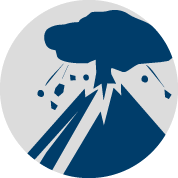 Volcano |
Volcanic events that cause damage or could potentially cause damage in Washington include eruptions, lahars, and ash fall. If the USGS issues a volcano alert level of 'Watch' or 'Warning' for a Washington (or neighboring) volcano, Clearinghouse management will consult with the USGS Cascades Volcano Observatory (CVO) to determine whether the Clearinghouse should be activated or on put on standby. CVO will serve as the lead for volcanic data collection and the Clearinghouse will assist them as requested. |
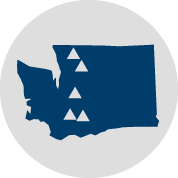 Multi-hazard event |
It is possible that there will be a multi-hazard event that requires activation of a Clearinghouse with multiple hazard Clearinghouse committees being called upon to respond to the different events (such as an earthquake and tsunami, or landslides caused by earthquakes). In such instances, Clearinghouse Management will focus on setting up Clearinghouse operations to best respond to the multiple events, with additional consideration of how to efficiently allocate Clearinghouse staff, facilitate coordination between the co-lead hazard committees and partners, locate the Clearinghouse, and generally manage a larger data collection effort. |
Who is involved

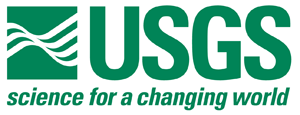
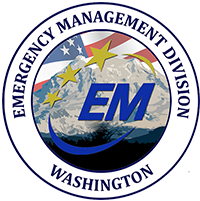
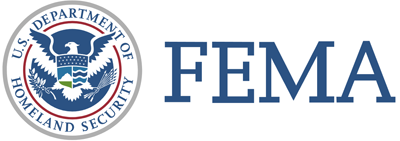


The Clearinghouse is a coordinated effort between earth scientists, engineers, and other professionals representing various state agencies, federal bureaus, universities, and private institutions. Clearinghouse partners include the Washington Emergency Management Division (EMD), the U.S. Geological Survey (USGS), the Earthquake Engineering Research Institute (EERI), the Pacific Northwest Seismic Network (PNSN), and the Federal Emergency Management Agency (FEMA), as well as other groups. The Clearinghouse is divided into committees that are responsible for leading the Clearinghouse after specific disasters occur (earthquake committee, landslide committee, tsunami committee, and volcano committee) and other committees that provide support (outreach committee, remote sensing committee, logistics committee, and data & information technology committee).
Any scientist wishing to join the Clearinghouse and collect data is welcome to participate. Reach out via the contact information below.
Contact the Clearinghouse
Email: clearinghouse@dnr.wa.gov
Phone: 360-902-1450 (WGS General Information Line)
Clearinghouse Resources
Field Data Collection Forms
Click here for links to the field data collection forms.
Clearinghouse Plan Appendices
Appendix A: List of Core Participating Agencies and Points of Contact
Appendix B: Clearinghouse Operating Procedures and Instructions
Appendix C: Instructions for Field Investigators and Survey123 Forms
Appendix D: Field Safety Notes and Resources
Appendix E: Equipment for WGS personnel and Clearinghouse Facility
Appendix F: Clearinghouse Meeting Templates and Situation Report Template
Activation call meeting template
Planning meeting template
Evening briefing meeting template
Situation report template

